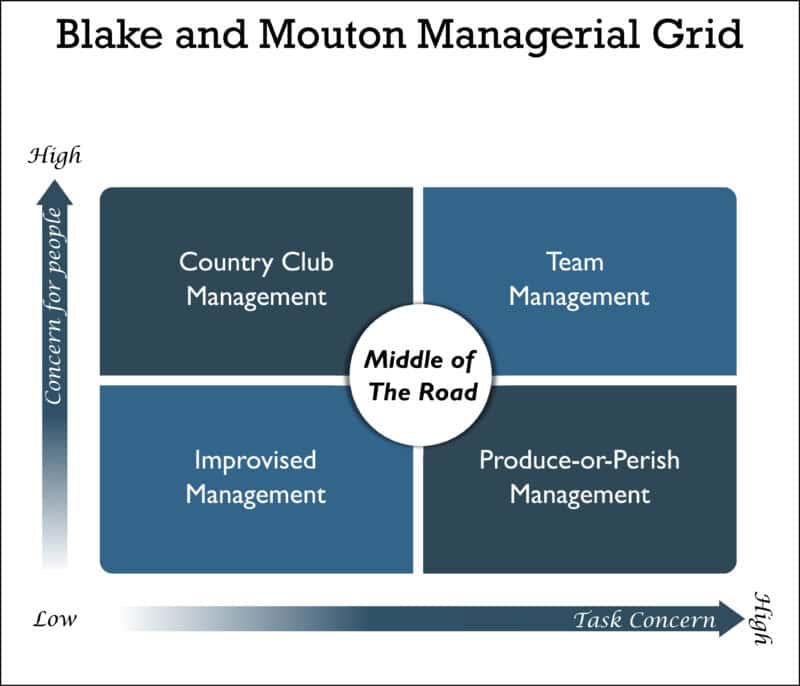What leadership styles are there? Which management style is right for you?
Leadership styles
Leadership styles are as different as the managers who have them: even in one and the same company with an identical corporate culture , leadership personalities and therefore also their leadership styles can vary enormously.
But even if very different characters with diverse biographies are in leadership positions, their leadership practices can be summarized in leadership styles. In this article, we will introduce you to all leadership styles and look at how the understanding of leadership has changed over the decades.
We have found that corporate culture, management style and employee behavior are always based on the values of the people in question, i.e. what is really important to them. Based on this insight, we will focus in particular on the value-oriented management style.

Leadership style definition
A management style is the way in which a manager behaves in the long term towards the employees to whom he or she is responsible.
What does leadership style mean?
leadership style:
- How is hierarchy practiced?
- Does a manager tend to command & control or ask how they can support their employees?
- Are there detailed guidelines or do employees have room for self-organization?
- How does a manager react to errors and deviations; what kind of error culture does he or she have?
- Does only the manager give feedback or does he or she also receive feedback?
- Does it consider its own ideas to be effective or does it collect ideas from employees?
- Who makes which decisions? The management style encompasses all dimensions of the interaction between managers and employees.
Management style and corporate culture
The way in which people are managed is fundamental to the corporate culture and the atmosphere in the company. And these in turn have a major impact on the success of an organization. Some management styles work with the right team, but are out of place in other companies. For example, trouble is inevitable when a rather authoritarian boss wants to bring the young team of a tech start-up up to speed. And conversely, it would be a big change for the tightly managed employees of a conservative company if lateral management suddenly appeared and expected an agile mindset from the workforce.
Every management style has advantages and disadvantages. And not every leadership style is suitable for every leader or every company.
It is therefore worth taking a look at the different leadership styles in order to consciously choose the one that suits you best.
We would also like to point out that there are rarely pure management styles in everyday business life. These are usually mixed forms with a more or less clear tendency.

Why is a good management style important?
The Gallup opinion research institute regularly publishes the so-called Engagement Index. This shows how motivated and committed employees are to their work and their company.
The consequences of poor leadership
The results are always devastating: in Germany, only 13% of employees felt connected to their company in 2022! 21% had even already resigned internally. A total of 69% felt little or no connection with their company and only do the bare minimum. And 41% always keep themselves informed as to whether there are better opportunities for them. One of the main reasons for this is poor leadership!
The consequences are high costs due to fluctuation and service by the book. And once the worm has turned, demotivation takes hold: there is a lack of consultation, tasks are completed poorly or incorrectly, the sickness rate is high, new ideas do not emerge. The Federal Statistical Office has calculated that the costs of a lack of motivation in 2022 amounted to between 118.1 and 151.1 billion euros.
The crux of the matter: according to an older Gallup study, 97% of managers rate themselves as good managers. However, employees rated their managers very differently: 69% stated that they had ever worked with a bad manager.
The results of good leadership
In contrast, good leadership can motivate people to work above average.
If people are satisfied with the company and their superiors, they are usually not interested in looking for a new employer. And that is an important argument, especially in times of skills and labor shortages. In addition, the management style is often an important criterion for people who may want to join your company.
And of course, the more motivated your employees are, the more your company can achieve.
This means that your company needs satisfied, motivated employees and that requires a sensitive, level-headed management culture.

Leadership style and values
What do values have to do with leadership style?
Values are what is really important to people – and that can of course vary considerably: Annegret is committed to fairness, Thomas believes it is important to build up wealth and present it, Tania thinks it is important that everyone adheres strictly to the rules, Denise needs a lot of freedom, Thomas always wants to be the best, Ann Sophie is prepared to do without anything as long as it is good for the planet. And Bettina does the same, but only for her family. Norbert thinks it’s important that people treat him with respect – after all, he’s earned it; Johannes needs authenticity in his dealings with each other, he finds anything else untrustworthy.
Values and conflicts
Tania and Denise clash again and again at the company because Tania is very strict about the rules, but Denise feels that this restricts her freedom and even makes her feel like she’s being bullied. Ann Sophie can’t understand why Michael has to drive up in a big SUV. And Michael finds Ann Sophie’s criticism of his daily ham sandwich exaggerated and cheeky. While Annegret emphasizes that everyone in the team has made their contribution, Thomas points out that he would have made a much better contribution. And Norbert finds Johannes’s jokes and colloquial directness flippant to provocatively disrespectful, while Johannes finds Norbert’s manners artificial, outdated and not very human.
As you can see, when people interact with each other, their values have a big influence on how and what they talk about, what they think of each other, what they focus on and so on. This means that the values of managers and employees can either harmonize or collide with each other. It is therefore worth taking a look at values, value management and value-oriented leadership.
Values in the company
The corporate culture of every organization is based on values:
- How do we want to deal with each other?
- What is really important to us?
- How do we present ourselves to the outside world?
- How do we deal with difficulties or mistakes?
Values and management style
Values also form the basis for the behavior shown in the management style:
- What image of humanity do you have?
- What manners are important to you?
- What is respect for you?
- What makes an authority?
- Where do you assume competence? How do you recognize them?
- What qualities should a boss have?
- How should employees behave?
Value-based leadership
Why value-oriented leadership?
Values are what is really important to people; what intrinsically motivates them and makes them strive for a certain goal in a certain way.
Leadership is an external influence that attempts to accompany or guide people so that a certain goal is achieved in a certain way. Of course, it is ideal if these two forces work together and not against each other.
Wouldn’t it be wonderful if employees really cared about what they do for a living? If they had the same enthusiasm, joy and creativity at work as they do in their hobbies or wherever else they are involved – in clubs, in the family, in voluntary work? Instead of dragging themselves to work unmotivated, as Gallup regularly attests.
We have written a comprehensive article on this topic: Why value management makes your company successful
A little note on this: We summarize all the articles we recommend at the end of this article in the recommended reading section.
How to start with value-oriented leadership? The values profile
Our 25 years of experience as consultants have shown that it pays to determine which values dominate the company. Here we ask:
- What values do the individual employees have?
- Which values are actually practiced in the company on a day-to-day basis?
- What values does the company need to be successful?
A value analysis is very useful here. To do this, we use appropriate questions via a card game or app to get employees talking to each other. The value profile shows the extent to which the values of the employees, the current corporate culture and the corporate strategy are aligned.
If we know what motivates people in the company, we can respond accordingly and adapt our management behavior accordingly. In this way, we create a corporate culture that benefits everyone: the shared values serve as guidelines for the behavior of all managers and employees and thus contribute to a positive, ethically oriented working environment.
Do you want to know exactly how to create and evaluate a value profile? We have described it in detail here: How to create a value profile

The basics of value-based leadership
The basis is the work of psychologist Clare Graves, who developed the Graves Value System GVS. The Graves Value Model, also known as Spiral Dynamics, describes the evolutionary development of individual and collective values and ways of thinking. The model divides the evolution of values into eight different stages or “memes”, with each meme representing a specific way of thinking, behavior and values.
Here you can find out more about the origin and background of the GVS (Graves value system).
The values of value-based leadership:
Roughly speaking, the eight memes are value clusters that revolve around the following values:
- Survival
- Identification and consistency
- Strength and enforcement
- Rules and order
- Performance and success
- Community and social affairs
- Openness and freedom
- Sustainability and a holistic approach
The subject matter is too extensive to describe in detail here. Incidentally, we have already done this elsewhere. If you want to know exactly what the individual memes mean and contain, read our article on this: The 8 value clusters (memes) of the Spiral Dynamics Model according to Graves

The key characteristics of value-based leadership
-
Defined values:
The entire workforce defines the values and ethical principles that form the basis of the corporate culture. This promotes understanding of and commitment to the established principles throughout the company. What doesn’t work is when managers single-handedly come up with nice-sounding values and impose them on employees from the top down.
Examples of shared values include trust, goodwill and speed. -
Role model function of managers:
Managers exemplify the defined values. They show employees how these values can be put into practice.
With the values mentioned above, this can mean that the manager trusts the employee and that the employee can make their own decisions so that the customer’s problem can be solved quickly and accommodatingly. -
Consistency:
Values-based leadership requires consistency in the application of the defined values in all processes and in day-to-day dealings with employees, customers and other stakeholders.
It is not enough to pay attention to the specified values in a few areas. The values should be applied much more everywhere. And of course it takes stamina. -
Effects on decisions:
Value-based leadership influences decision-making and prioritization within the company. Decisions should be made in accordance with the defined values.
It would be inappropriate to monitor employees in detail when it comes to the value of trust. -
Employee participation:
Employees are encouraged to implement the values in their own behavior. Open communication with employees on values issues is essential.
-
Evaluation and adaptation:
It is crucial to review the effectiveness of values-based leadership and make adjustments where necessary to ensure that the values established remain relevant and effective.
Values and management style
We have applied the eight memes, i.e. the values that motivate people, to leadership personalities and leadership styles. What does this mean in day-to-day management? A few examples: If a person in a leadership position attaches great importance to rules and order, then this will also be reflected in the way they lead. If a person attaches great importance to collegial cooperation and harmony in the team, then what is really important to him or her will also be reflected in his or her actions as a manager. Regardless of the function in which we are currently acting, we are still a person with values all day long.
In our next article, we will take a closer look at the different leadership personalities, their leadership styles, preferences and values.
Here is a brief, rough overview:
- Survival (this value is not relevant in the corporate context)
- Identification and consistency (traditional, hierarchical)
- Strength and enforcement (control, loyalty)
- Rules and order (predictability, conformity)
- Performance and success (efficiency and target achievement)
- Community and social (team orientation)
- Openness and freedom (networking, flexibility)
- Sustainability and a holistic approach (visionary, pragmatic)

What leadership styles are there? The overview
First of all, we want to provide an overview of the leadership styles that have been identified so far. What does it help with? Perhaps this will help you to better categorize your own leadership style and reflect on the advantages and disadvantages associated with it. Do you like the result you achieve with it?
The history of leadership styles
Just as the world is changing and cultures are changing, so too is the way people interact with each other, including the way managers and employees interact.
In this respect, the concept of leadership style is subject to constant change. We invite you on a journey through the history of leadership that begins in the century before last:
Leadership styles 1900 – 1950
The German sociologist Max Weber (1864-1920) was the first to name four leadership styles. Since over 100 years have passed in the meantime, it is understandable that the management styles he described are now outdated. In these management approaches, the manager dominates and employees have no say. Generation Z would not need to come up with this…
In 1939, the German psychologist Kurt Lewin (1890-1947) identified three leadership styles, some of which overlap with Weber’s leadership styles. Here, for the first time, it is conceivable that those working in the company will also be granted scope for decision-making.
Leadership styles 1950 – 2000
In 1958, Robert Tannenbaum and Warren H. Schmidt developed the so-called continuum model. This illuminates the various shades of gray between the extremes of zero employee participation and complete decision-making autonomy.
In 1964, Robert R. Blake and Jane Mouton introduced the directional leadership style. This was based not only on the measure of employee orientation, but also on a second value: task orientation.
Bruce Avolio and Bernard M. Bass published the Full Range of Leadership Model (FRLM) in 1991, which deals with extrinsic and intrinsic motivators, among other things.
Leadership styles after 2000
Horst Joachim Rahn, a German business economist born in 1944, introduced the group-oriented management style in 2010. This assumes that a manager’s leadership style should not be based on their preferences, but that every person and every team needs a different type of leadership.
We will also take a look at other modern leadership styles such as lean leadership, lateral leadership, agile leadership and the servant leadership model.
The changing understanding of leadership
Overall, it can be said that the view of leadership has changed fundamentally since the first scientific observations: Initially, the focus was solely on the manager; employees were viewed more as assistants whom the manager commanded more or less benevolently from the top down. Over the decades, people without a management mandate were also given a say, albeit initially to a modest extent. Accordingly, leadership theories have mainly focused on who has to decide how much.
When the image of people changed around the 1960s, employees were transformed from living resources into people with idiosyncrasies that needed to be addressed, which sometimes seemed a little pedagogical. In the meantime, trust in the abilities of employees has developed: it is clear that employees can also think in the interests of the company and make good decisions. And the pandemic has taken a further step towards letting go of control. Until recently, time clocks were used to meticulously check whether employees had completed their time, but in many places there is now confidence that work is also being done outside the workplace.
In industries where it is possible and necessary, it is no longer a question of having employees carry out certain tasks, but of working together to shape what the company and its stakeholders need to move forward.

The management styles
Here are 12 approaches, each of which defines several leadership styles.
1. traditional leadership styles according to the sociologist Max Weber (1864-1920)
published posthumously in 1922.
1. the autocratic management style:
The manager is the boss and has 100% of the say and decision-making power. Contradiction is futile; criticism, ideas and comments are unwelcome.
Advantages of the autocratic management style
- Decisions are made quickly and are closely monitored.
- This can be a relief for employees who do not like taking on responsibility.
Disadvantages of the autocratic management style
- Very limited freedom for employees, which is no longer suitable for many people today.
As a result, employees are often demotivated – who wants to live in a dictatorship? - The boss may have less expertise than employees or, as the sole decision-maker, may be overwhelmed and make poor decisions.
- In times of skills and labor shortages, this is certainly not a management style that will attract applicants.
- As deviations are not tolerated, there is no room for innovation and new ideas.

2. the patriarchal management style
The manager acts as a strict, patriarchal father. Employees must follow the father’s instructions. A strict mother is also conceivable here. In contrast to the autocratic leadership style, the manager feels responsible for his or her subordinates. For example, it may have the aim of promoting employees. Otherwise, the roles are divided up and everyone knows their place. This type of company management is now only rarely encountered; when it is, it is mainly in family businesses. The advantages and disadvantages are similar to those of the autocratic style. One of the differences here is that the employees should at least be convinced of the correctness of the “fatherly” actions.
Advantages of the patriarchal management style
- Decisions are made quickly.
- Employees who are receptive to this feel safe, they are cared for.
- If the boss is charismatic and convincing, there may be more motivation.
Disadvantages of the patriarchal management style
- The mood in the company often depends on the whims of the boss.
- This corporate culture is also only suitable for a few people today – as a result, there are often demotivated employees here too.
- The boss can make bad decisions; may have less knowledge than employees.
- This type of leadership often goes hand in hand with a certain arbitrariness.
- There are favorites among employees and those who have to fight to be accepted.
- Unattractive for many employees, especially younger people.

3. the bureaucratic management style
It’s all about rules, rules, rules. For both employees and managers. Processes, plans and positions are clearly defined on the basis of guidelines. The management position is often fixed for a limited period of time. Here, everyone knows exactly what to do.
Advantages of the bureaucratic management style
- Everything goes according to plan, which can take the stress out of the team.
- Decisions are made on the basis of rules and guidelines and not on the basis of arbitrariness or sympathy.
Disadvantages of the bureaucratic management style
- Adhering to rules and hierarchies can slow down decision-making processes enormously, which does not work in the long term in our fast-moving VUCA world in many industries. In unforeseen situations or crises, you need room for maneuver and agility.
- As the framework and processes are clearly defined, no innovation, creativity or initiative can be expected here either.
- For many employees, this lack of flexibility can be demotivating or even frustrating.
4. the charismatic leadership style
There are managers who have great charisma and simply sweep the team along with their energy, vision and persuasiveness. There is no need for office or dignity here, such a boss can bring everyone on board with charisma, verve and eloquence. The leader is a role model. The employees are happy to participate, have responsibility and scope and thus a high level of identification with the team and the company.
(Note: For Max Weber, this was an idealized leadership style at the time, but the general view of charismatic leaders has become more critical as a result of events in the last century).
Advantages of the charismatic leadership style
- The fact that the employees are absolutely convinced of their task and the company’s vision means that their commitment and motivation are extremely high.
- Employees like to stay with the company, new ones like to join.
Disadvantages of the charismatic leadership style
- This management style makes it easier to exploit or self-exploit the workforce.
- This leadership style is linked to the personality of the manager: unfortunately, not everyone has charisma and charisma.
- And if we actually have a charismatic personality as a manager, this can also lead to no employee contradicting the opinions of the line manager because this manager is so convincing. And so the same applies here: the boss doesn’t always have to know best…

2. classical styles according to the psychologist Kurt Lewin(1939)
1. the authoritarian management style
The authoritarian and autocratic leadership styles are similar. There are also top-down instructions here. Still common in the military and police today.
Advantages of the authoritarian management style
- Clear command structures and responsibilities
- Quick decisions
Disadvantages of the authoritarian management style
- The position of the manager is the Achilles’ heel here: a mistake by the manager triggers mistakes in all subordinate positions; if the manager is missing completely, then the proverbial chicken runs without a head.
2. the cooperative management style
Nomen est omen: Here, people work together instead of giving orders, the manager delegates. Employees work in a self-organized manner and on their own responsibility. The management staff pay attention to the team atmosphere and motivation. Respectful interaction is important: everyone is allowed to contribute their ideas, feedback and critical thoughts, regardless of rank or role. This is characterized by many meetings in which, among other things, ideas are discussed and goals are set.
1. advantages of the cooperative management style
Due to the increased degree of freedom and design options, more initiative and motivation on the part of employees can be expected. This creates a better atmosphere and a pleasant corporate culture; it usually makes people feel very connected to the company, their colleagues and their job. Because employees have more responsibility and this does not lie with just a few managers, it is possible to react more quickly on site, for example at the customer, and the workforce remains capable of acting even if someone is absent. This is very relieving for the managers. As many perspectives are heard, there is a high probability that the decisions are good.
2. disadvantages of the cooperative management style
It’s not just one person in the lead, but everyone. This can mean that there is a power struggle between those involved or that processes are prolonged by endless meetings and discussions and decisions are not made on time. It can also happen that the leadership is not taken seriously.
3. the laissez faire management style
In principle, anyone can do as they please here. Laissez faire (French) means to let do. The freedom of action and decision-making of the employees is characteristic here. Who works on what and when is decided alone or in a team. The managers are not asked; they do not control, but they do not support either. The employees are largely left to their own devices.
Advantages of the laissez faire management style
- Employees have the freedom to make their own decisions, which can increase their motivation and satisfaction.
- With more freedom, employees can be more innovative and develop personal approaches to solving problems.
- Managers who spend less time monitoring can focus on more strategic aspects of the work.
Disadvantages of the laissez faire management style
- Depending on how employees interact with each other, chaos can arise, for example if tasks are completed incorrectly due to a lack of communication.
- There may be a lack of orientation and direction.
- Group dynamics can get out of hand: Competitive wrangling because everyone wants to push their own ideas or bad mergers that lead to bullying.
- There is also often a lack of feedback because no one takes responsibility for the further development of the team.
Laissez faire is not everyone’s cup of tea and it depends on people how they fill the leadership vacuum. There are many personalities who prefer to have a certain amount of leadership.

3. leadership styles according to Tannenbaum and Schmidt: the continuum model
In 1958, Tannenbaum and Schmidt identified seven leadership styles that gradually transition from an authoritarian leadership style to a democratic leadership style. At each step, employees are given a little more information and a say.
-
Authoritarian management style
As usual: the manager decides alone.
-
Patriarchal management style
As usual: the manager decides alone, but tries to convince the employees of their decision.
-
Informative management style
The informative management style is very similar to the previous ones, but here the employees can at least ask questions.
-
Consultative management style
In the consultative management style – as the name suggests – employees are allowed to put forward their ideas and concerns and advise the manager. The decision-making power remains solely with the manager.
-
Participative management style
The employees develop various possible solutions. Here too, the manager alone decides which he or she considers to be the most sustainable.
-
Delegating management style
The manager presents and explains a decision and the employees are allowed to vote for or against or within a certain margin.
-
Democratic management style
Here, it is the employees who make the decisions.
4. the directional leadership style according to Robert R. Blake and Jane Mouton
Blake and Mouton developed the Managerial Grid in 1964. This is a coordinate system with X and Y axes that describes the relationship between two variables. These are the employee orientation and the factual orientation. Leadership behavior can be more or less pronounced in each of the two variables and in different proportions to each other. There are no predefined management styles here. Of course, the maximum employee AND task orientation is seen as ideal here.

5. situational leadership style
Ken Blanchard and Paul Hersey published the situational leadership style in 1969, which focuses on adapting the respective leadership style to the individual needs and abilities of the team members. Blanchard and Hersey assume that there is no one-size-fits-all management style that is suitable for all situations and employees. Instead, four basic management styles are identified, which should be applied depending on the employee and the situation. There are similarities and overlaps with the management styles already mentioned.
-
Instruct (delegate):
The supervisor makes decisions and gives clear instructions. This style is used for employees with low competence and motivation.
-
Explain (support):
The line manager explains decisions and encourages open communication. This style is used for employees with low competence but high motivation.
-
Participate (Involve):
The line manager and the team work together on decisions. This style is used for employees with high competence but low motivation.
-
Delegate (Delegate):
The line manager largely transfers responsibility and decision-making authority to the team. This style is used for employees with a high level of competence and motivation.

6. servant leadership model
In 1970, Robert K. Greenleaf, former manager of the telecommunications group AT&T, developed the model of servant leadership. In servant leadership, managers are the ones who lead the way through their vision and example. Secondly, they ensure that employees have all the options available to them to carry out their tasks. The focus is on people and their needs and the manager responds to the personalities, needs and skills of the individual and supports the team and employees. Employees can make their own decisions within a defined framework.
Advantages of the servant leadership model
are the promotion of a strong sense of community and togetherness and thus a high level of identification with the company. This often results in a high level of employee satisfaction. This makes the company attractive, especially for young employees. The servant leadership management style supports innovation, reduces fluctuation and ensures quick decisions on site, at the customer.
Disadvantages of the servant leadership model
the focus on consensus within the team and the individual support of each employee are time-consuming and require special skills from the manager. Servant leadership is not suitable for everyone: Not every manager has the empathy, and not every employee is willing or able to organize themselves. Servant leadership has to be learned.
Servant leadership is particularly suitable in industries that are close to the customer or where there are frequent changes.

7 FRLM – Full Range of Leadership Model
The Full Range of Leadership Model from 1991 is a leadership theory that identifies three leadership styles:
-
Laissez faire management style
We have already discussed this management style above. Here, the employees organize themselves, with little or no intervention from management, for better or for worse.
-
Transactional management style
Shows the type of leadership that works with extrinsic motivation. What does that mean? Work is a trade: the company gives money, the employees work. Both have clarified their expectations beforehand. This management style can be suitable for standardized or simple tasks.
-
Transformational leadership style
If the activities require creativity, innovation and collaboration, then the transformational management style is more appropriate. This is about employees sharing the company’s values, goals and visions. This creates intrinsic motivation, more team spirit and a willingness to perform.
8. lean leadership
Lean Leadership and Leon Management originated in Japan in the early nineties and, to put it very simply, have optimization in mind. On the one hand, this means avoiding waste and increasing profits; on the other hand, lean leadership is geared towards developing managers so that they are better able to fulfill their management tasks. This is followed by support for all employees so that they can expand and develop their skills. In this way, lean leadership aims to enable companies to face future challenges as well prepared as possible.
9 The group-oriented management style according to Horst-Joachim Rahn
Horst-Joachim Rahn does not focus on the leader, but on the people being led. The group-based leadership style of 2010 is therefore not about the leader choosing a particular style with which to lead. This is based on the realization that because every employee has different needs, situations, character traits, values and so on, they naturally need leadership that is adapted to them.
The group-related management style is about the behavior of the employee in the group.
Advantages of the group-based management style
- Every employee can be catered for.
- The mood in the group is consciously influenced positively.
Disadvantages of the group-based management style
- The group-oriented management style is often not easy to implement in practice.
Rahn recommends six different interventions:
- Incentivizing underperforming employees by setting targets.
- Putting the brakes on grumpy, querulous colleagues for the sake of team morale.
- Encourage reluctant employees.
- Integrating colleagues who tend to remain on the fringes of the team.
- Appreciate team members who act positively and constructively in order to reinforce these behaviors.
10. lateral guidance
Lateral leadership means leading without power. Lateral leadership is a modern management style which, in contrast to classic hierarchical management styles, operates at eye level. Here, disciplinary authority is dispensed with, but instead persuasion and enthusiasm are used. Managers need knowledge of human nature, empathy and tact; employees need the ability to organize themselves. Lateral leadership and servant leadership have many overlaps.
We have written a detailed article on this that will answer all your questions: Lateral leadership – tips for leadership without power.

11. agile leadership
Agile leadership is a collective result that has been shaped by the agile community and various experts. Agile leadership is similar in many ways to the servant leadership model. Here, too, the aim is to enable employees to carry out their tasks independently on an equal footing. But agile leadership goes even further than that: based on the assumption that today’s world is in a state of permanent VUCA change, agile leadership strives to enable companies and employees to master changes and unforeseen challenges quickly. Agile leadership takes the needs of all stakeholders into account.
We have also published a very detailed article on this topic: Agile leadership – What is agile leadership? The 10 principles
12. value-based management style
In 2024, Susanne, Christian and Oliver Grätsch from the berlin team published the book Value Party, in which they set out their approach to value-based leadership.
What? A book? Yay!
We are also very excited: our book is as good as finished: FAZ Verlag will publish our book in 2024. Here is an overview:
ValueParty
ValueParty – Value-based business transformation is an approach that enables organizations to bring speed to the road based on shared values. The berlin team has developed a practical transformation model:
The ValueParty is a tool, a process model and a procedure with which organizations can maintain their survival kit in a stable and dynamic way: If you know your value base, you don’t have to motivate your employees.
Based on clear values, the aim is to take off with the strength and intelligence of an entire organization and secure future prospects. Managers are given practical levers to establish a common value base in the organization: How can culture be developed? How can we gain clarity about what is important to the individual, what is lived in the company and what will carry us into the future? How can we formulate values together systematically and with clarity? The ValueParty is fun and creates clarity!
Click here for the ValueParty.
And here we proudly tell you about our book ValueParty, which will be presented at the Leipzig Book Fair:
How does leadership work in practice? The basics
That was a lot of leadership styles, wasn’t it?
If, after all that theory, you need a bit of entertainment and practical relevance in terms of leadership, then we’d be happy to tell you about our experiment: we used the basics of leadership to turn a loose bunch of anonymous gamers into a high-performance team. Yes – that’s possible!
Leadership: 11 steps to successful leadership everywhere!
Which management style is best?
You’ve probably already guessed it: why would we list all the leadership styles here if it were enough to simply name one as the best?
Yes, it would be nice!
However, our experience shows that we can achieve the most with values-based leadership, as it incorporates many of the leadership styles mentioned above. But – it goes beyond that: the needs of the company and its customers, as well as the values of the people in the company, are taken into account. Management behavior can be adapted to the respective circumstances. The fact that employees feel seen and heard as people and the communication of values creates an impetus for the corporate culture. This impulse has a lasting positive impact on the corporate culture, team spirit and motivation if the values are acted upon and managed accordingly.
Which management style is right for you?
To fine-tune your own management style, it is first important to look at the basics:
- What kind of work?
- Which sector?
- Your personality?
- Your employees?
- The corporate culture?
- The values in your company
And to identify the values in your company, use our app, our card game set or give us a call. We are delighted.

Reading and media on the topic of leadership styles
Want to know more about leadership styles? Great, then we have a few articles for you here that might interest you. Enjoy reading:
The 7 leadership personalities & their values
Why values management makes your company successful
Changing values: definition & guide to cultural change in your company
How to create a value profile and use it to change your company
The Spiral Dynamics value model: what is really important to people
The Graves value system: what is really important to people
Leadership: 11 steps to successful leadership everywhere!
Agile management, agile leadership
And here you can find some external sources:
Report on employee motivation / Engagement Index 2022 / 2023 by the Gallup Institute.
Viadee Spark has written an article about the Value Party method we developed.






















